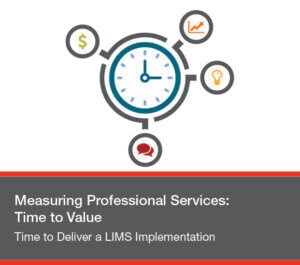 Our customer success organization puts a strong emphasis on identifying the right metrics to ensure alignment with customer expectations during deployment. We are excited to share the metrics our company views as the strongest indicators of our process efficiency and our clients’ success, and invite others to share their experiences.
Our customer success organization puts a strong emphasis on identifying the right metrics to ensure alignment with customer expectations during deployment. We are excited to share the metrics our company views as the strongest indicators of our process efficiency and our clients’ success, and invite others to share their experiences.
Time to Deliver a LIMS Implementation
Our main objective is getting the software into the hands of end-users quickly. Whether a customer was choosing between different vendors and applications, or making the decision to replace a home-grown system, clients typically begin deployments with aggressive goals and have internal KPIs to demonstrate value to their business with the selected laboratory data management system. We promote an agile, phased deployment approach, with incremental roll-outs to TEST and PROD, to promote smoother adoption on the customer’s side and to showcase progress throughout their organization.
Time to production is heavily dependent on the customer’s resource availability to develop their SOPs, conduct User Acceptance Testing (UAT) and train their end users, generally taking 2-4 months for the first deployment, and half that time for subsequent roll-outs. In total, deployment timelines for these large, complex projects average less than 6 months versus 12-18 months (as is common in the informatics industry).
Delivering a LIMS within budget
Projects start with a deep dive into requirements, working with our customers to understand and prioritize their user stories and define a User Requirements Specification (URS) that dictates the solution design. Although clients share their objectives during the sales process, we appreciate that their priorities and scope can change. Priorities can shift as customers engage more with our team, see the functionality materialize through demos, and have their own internal changes. We anticipate and work with our customers when this happens. But, going back to our first metric, our biggest driver is to get the customer into production – quickly and with functionality that will begin to generate value for the customer organization.
We deploy a solution framework which can expand with the customer as their business needs grow or change, and which can also be maintained by key users over the long term. Laboratory information management systems (LIMS) are highly configurable and our implementation methodology includes training customer resources on how to configure it for longer term platform evolution and expansion. When scope changes are identified, we work with our customers to prioritize against earlier requirements to ensure minimal impact to deployment timelines.
Customer provided satisfaction ratings
We set internal targets for delivery on time and within budget, but in the end, the single most important success indicator for us is feedback we receive directly from our clients. Our project implementations are collaborative engagements requiring active participation from the customer’s project team. We want to ensure the solution deployed meets the business objectives of the customer. We achieve that goal through regular solution demonstrations and feedback sessions, as well as phased UAT. We also solicit feedback on our work processes and ask our customers to complete surveys (including the option to remain anonymous) after key milestones in the project (URS finalization, UAT completion, and PROD deployment). We collect feedback on areas including communication, meeting of expectations and usefulness of documentation, and ask our customers to rank on a 5-point scale of poor to superior.
By receiving feedback throughout the project implementation, we have the opportunity to adjust our approach with each customer as the project progresses, versus collecting feedback only at project close-out to improve for the next project and next customer. In the cases of phased deployments for UAT and to PROD, the customer team is asked to complete the survey each time, which offers us a chance to quantitatively measure improvement.
For example, in the past our customers were expected to develop their own UAT scripts, but they didn’t always have enough system knowledge to feel confident in developing these scripts. Because of this, time to complete UAT was longer than anticipated and customers weren’t sure if a UAT finding was a bug or a training issue. We then began developing UAT scripts for our clients. As a result, UAT related survey questions were consistently ranked at the highest level, time to complete UAT dropped by half, and clients shared feedback that the scripts were also multi-purposed as useful training tools for onboarding new team members and providing a basis for Performance Qualification (PQ) for our regulated clients.
Leave a Reply